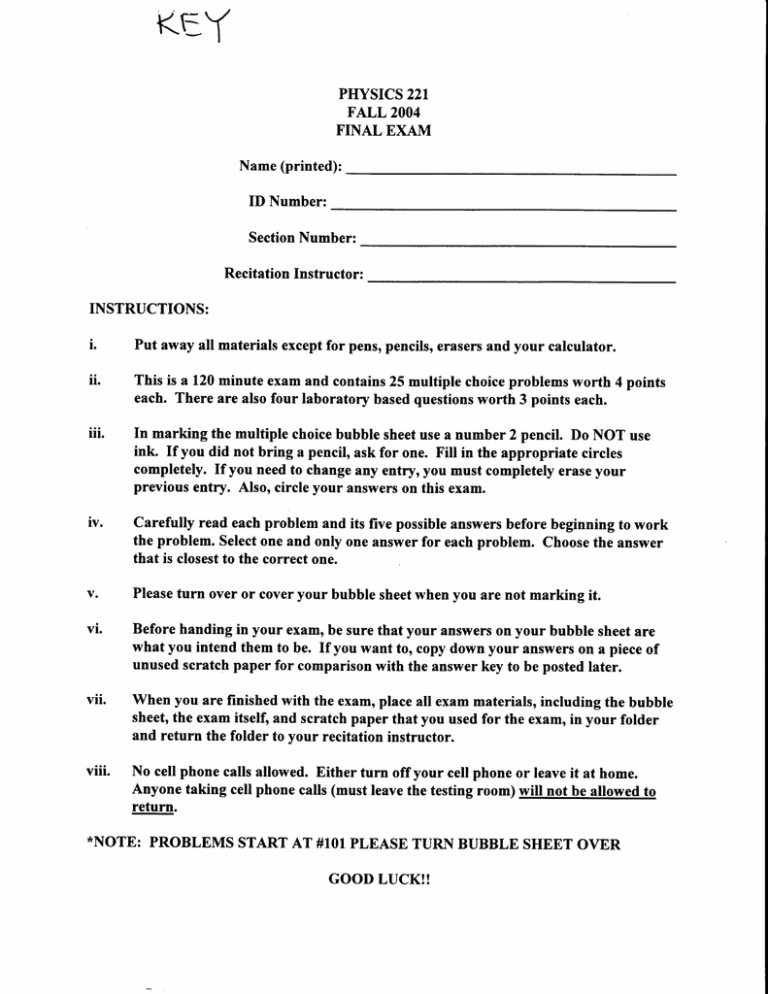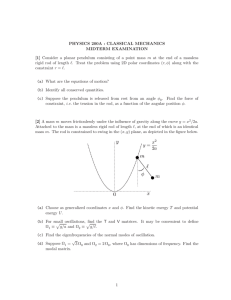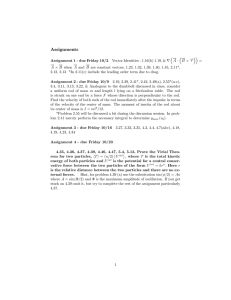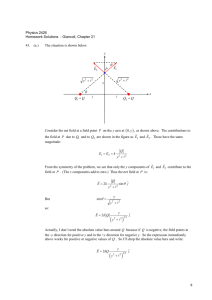KtrY PHYSICS 22I FALL 2OO4 FINAL EXAM
advertisement

KtrY
PHYSICS22I
FALL 2OO4
FINAL EXAM
Name (printed):
ID Number:
SectionNumber:
Recitation Instructor:
INSTRUCTIONS:
i.
Put away all materials exceptfor pens,pencils,erasersand your calculator.
ii.
This is a 120 minute exam and contains25 multiple choiceproblems worth 4 points
each. There are also four laboratory basedquestionsworth 3 points each.
iii.
In marking the multiple choicebubbte sheetuse a number 2 pencil. Do NOT use
ink. If you did not bring a pencil, ask for one. Fill in the appropriate circles
completely. If you need to changeany entry, you must comptetelyeraseyour
previous entry. Also, circle your answers on this exam.
iv.
Carefully read each problem and its five possibleanswersbefore beginning to work
the problem. Selectone and only one answer for each problem. Choosethe answer
that is closestto the correct one.
v.
Pleaseturn over or cover your bubble sheetwhen you are not marking it.
vi.
Before handing in your exam, be sure that your answerson your bubble sheetare
what you intend them to be. If you want to, copy down your answerson a piece of
unused scratch paper for comparisonwith the answer key to be posted later.
vii.
When you are finished with the exam, place all exam materials, including the bubble
sheet,the exam itself, and scratch paper that you used for the exam, in your folder
and return the folder to your recitation instructor.
viii.
No cell phone calls allowed. Either turn off your cell phone or leave it at home.
Anyone taking cell phone calls (must leavethe testing room) will not be allowed to
return.
*NOTE: PROBLEMSSTART AT #101PLEASETURN BUBBLE SHEET OVER
GOOD LUCK!!
PHYSICS 22I
FINAL EXAM
FALL 2AO4
101) A 200 kg box restson the floor of an elevator. If the elevatoris acceleratingupwardwith
:
lul 3.00 m/s2, what work is done by the normal force exertedby the floor on the box as
the elevatorrises 10.0m?
A.
B.
C.
D.
'l'-'
OJ
6 . 0 0x 1 0 3J
1 . 3 6x 1 0 4J
1 . 9 6x 1 0 4J
2.s6x 104J
(9
,rl;l
t o 2 )u : o
A. Implies d must be zero.
B. Implies d must be perpendicularto i.
A ImplieslS I mustbezero.
to i or l# | ir zero.
@(!,) Canimplythatd is zero,d is perpendicular
E. It cannotimply any of the above.
I 03)
D
-_>
C
rl
F
h
Four identical blocks are attachedto eachother by masslessrope (or stacked)as shown
and they all move togetherwhen force F is appliedas shown. Find the ratio of the net
forceonblockA andC, ie ffi : f
A i
e!
E.4
from a string(of negligiblemass)of length40.0cm
104) A simplependulumis constructed
2.00
kg. If we wantto usethe samemassto createa
anda point-likemassm
oscillatorwith the sameperiodof oscillation,whatspringconstantk must
spring/mass
the springhave?
A.
B.
C.
D.
.4,
2.04x l0-2N/m
8.16x l0'2N/m
6.14N/m
12.25N/m
(!J 4e.0N/m
105)
Io -\
In the circuit shown. if the voltage acrossthe 3.0 0 resistoris 9.0 V, what is the current
through the 10 Q resistor?
A. 0.9 A
(P r.sA
c. 2.7A
D . 3 . 0A
E. Cannot determine,insufficient information provided.
I 06)
A copperwire has a massfl, I lenglh (.i, anda resistanceRi. If this wire is now reformed
into a new copperwire with the samemassm, but a length of 2 (.i, what is this new wire's
resistance?
A. 0.25Ri
B. 0.50Ri
C . 1 . 0R i
A
2.oRr
( E.\4.0 Ri
\J
107)
What is the capacitanceof the parallel plate capacitorshown below if one half
(an areaof f ) of the capacitorhas a K = 3.0 dielectric material filling the gap and the
otherhalf is simply vacuum?Let A: 1.00cm2andd = 0.100mm.
-
t
I
l - - 1 -
' ' \ )
\ \
\ ' (
\\,
\,,
'1.
./
A . 2 . 2 1x 1 0 - r 2F
B. 4.43x l 0 - r 2F
C . 8 . 8 5x l 0 - 1 2F
I
@ @r . 7 7 xl 0 - rI F
E . 3 . 5 4x l 0 ' l F
108)
A 12 V batteryhasan internalresistanceof 5.0 CI. If a 1.0 Q resistorand a 3.0 CIresistor
are placed in serieswith the batteryso as to make a completecircuit, what is the voltage
acrossthe 3.0 Q resistor?
L
3.0v
qy4.0v
c. 6.0v
D . 8 . 0V
E. 9.0V
A 3-g particle moves subjectto the force associatedto this potential.No other forces act on the
particle.
r20
t
I
I
/
100
/
/
80
60
U (J)
f
/
\
/
\
40
/
\
/
\
,/
/
\
7
\
\
0
/
\
./
\
20
,/
\
/
,/
6
x (m)
l0
t2
109) Theparticleis released
from restat x : I I m. Whatis the maximumkineticenergyof the
particle?
A. 2OJ
B.3OJ
C. 5OJ
D. 6OJ
6
sol
\_/
Find the x componentof the force at x - 7 m.
1l0)
z^
\AJ O
B.
c.
D.
E.
+7.3N
-7.3N
+30N
-30N
rl l)
k= \o.* tJi*
Pk=C.5oO
- 5 , o€
4.n
Cpo
f l-sro
A springwith k: 10.00N/m is compressed
by 5.00 cm by a 5.00 g mass. If the
:0.500,
coefficientof friction ir po
what is the mass'svelocity when the springit is
attachedto is expandedby 2 cm?
A. 1.59m/s
-4, 1.73m/s
( C.J1.87m/s
D. 1.96m/s
E. 2.05m/s
ll2)
Two massesapproachthe origin as shown
and undergoa completelyinelasticcollision.
The resulting combinedmasshas a final velocity
Vf : vr j . What ratio of the magnitudes
of iei and Vsl can lead to this result?
<
,
^
l/1v",
lvo,
|:
L{O"O
A. 3.8
B. 2.0
c. r.0
D. 0.61
a::T)ro.so
A
lo"ok?
{o,o
\rrc
s,ooLZ
113) Whichof the followinggraphsbestrepresents
the lgfrll fo. anuniformlycharged
insulatingspherewith chargedensityp[coulomb/meteC]?
I 14) Two point chargesarelocatedon thex-ar<is.gr is at x:0 m andgz is locatedat
x:4 m. If E:0 at x:3 m whichof thefollowingsetsof charges
couldb. qr md qzr
,n
92:I nC
\AY9r:9nC
B)
C)
D)
E)
I l5)
el:3nC
gl:-3nC
e l : - 1 8n C
qr : 4 nC
g2: lnC
g2:1nC
ez:Z nC
g2:4 nC
A massis launcheddirectlyupwardalongtheradialdirectionfrom the earth'ssurface
with an initial speedof I .00km/s. Whatwill themass'sspeedbe whenit is 2000km
from the earth'ssurface?
A) 2.23km/s
B) 4.46kmls
C) 6.19km/s
D) 8.38km/s
2000km aboveearth'ssurface.
@lmpossible questionsincethemassneverreaches
\--l
116) A squareof side20 cm is placedon thex z planein a regionof spacewherethe electric
of thenetelectricflux
field is E: (100 Ull - (200Hll Whatis themagnitude
throughthe square?
A)4.0N.m2lC
A5.l N'mzlc
( c) )8.0N . m2lc
\ t f 8 . eN . m z t c
E i 1 2N . m 2 t c
Thenegativecharge
Two point chargesQ and-a (a: 15.0nC) areplacedon thex-a><is.
is at x : *2.00 cm andthepositivechargeis at x - -4.00cm.Determinethe electricfield
at x : 0.00cm,on thex-axis.
ll7)
A) + 2.53x 105N/C ?
B ) - 2 . 5 3x 1 0 5N / C ?
.
c )^ 0
.
-
( ol) + 4.21x lo5N/c i
Y - 4.21x losNlc ?
118)
A personhasjust arrangeda 5.0-m long, uniform, boardof mass10 kg so that it rests
atop two wedgesplacedunderthe left end and 2.0 m from the right end. as shown in the
figure below. A small (point, mass-like)box is placedon the right end of the board.
What is the maximum box massthat can be placedwithout the board tipping?
q)uF,
D) 7.4ekg
E) e.99.ks
I I 9)
A force F out of the pageis applied
at point P to a dumbbell shapedobject
made of two uniform sphereseachof
massm and radius L and a single rod
with massm and length L. One of the
spheresis made so that the systemcan
rotate about axis A. Find the magnitude
of the angularacceleration.
A . a : 0 . 1 2ML4
,'^
( e . )*a : 0".' -2
" 54
mL
\;/
IL
C. a :0.50
"m
D. a:0.75
- m4L
E . a : l . I ? ' mL L
Arts
PSfnrt"''
120)
A thin ring (with masslessspokes)of massM and
radius R has a masslessrope wound around it.
The rope is also attachedto a smallermassm
which startsa height h abovethe floor. Which
expressiongivesthe speeOlul of m just beforeit
hits the floor?
A.
\ b t
2 mgh/(M + m)
U.
D. 4mgh/(M+2m)
E. None of the above.
The units [N . s] are appropriateunits for
l2l)
A. acceleration
.p. kinetic energy
@momentum
D. potential energy
E. rotational moment of inertia
122)
The figure shows sketchesof the parabolictrajectoriesof four identical projectiles. Each
is launchedwith a different initial speedand angle. Which shell will be in the air the
longest?
Y
A.A
B.B
C.C
D.D
Qeu
projectileswill be in the air for the surmeamountof time.
A smallbox of massm : I .0 kg startsmovingup an inclineangled40owith respectto
the horizontal.The speedof thebox at thebottomof the inclineis 3.0m/s,andthe magnitudeof
thebox'sacceleration
is 7.0 mls2.
123) How high verticallyabovethe startingpointdoesthebox go?
A. 0.20m
8.0.38
.A
q9 0.41m
D. 0.64m
E. 0.75m
124) Determinethe coefficientof kineticfrictionbetweenthe box andthe incline.
,7l',
(A.)
B.
C.
D.
E.
Fk:0.093
F k : 0 .1 3
Fk: 0.26
Fk: 0.57
Fk:0.89
125) A particlehasa time dependent
acceleration
a(t)- (6$) t -14$ for positivet. If the
particlehasa velocityof 10m/s at t : 0, how far will theparticlemovebetweentimes
t:0andt-10s?
A) 46m
B ) 1 7 0m
,I\300m
( D)J400m
Y5oom
PHYSICS221- Fall, 2004
LaboratoryFinal II
Considera cart whoseposition is measuredwith an ultrasonic
transducer(a "motion detector"), as you did in lab. (Assumethe
'sensorgives positions relative to the X axis illustrated in the
figure).
126)
Which of the following representsa graph of position vs. time that
might result when the cart is acceleratingat a fixed. positive rate?
c
A
E)
127)
None of the above graphs.
The trajectory of a puck sliding freely on a level air table
is recorded(as done in 221 lab) on a piece of (metric)
graphpaper,shown at the right. Assumethat the spark
generatorwas operating atarate of 60 Hertz, and that the
figure at the right is approximatelyfull scale.
Estimatethe magnitudeof the X component of the
velocity of the puck (in cm/s).
A) ro3
@-
c) 60
D) 0.02
E) It is not possibleto calculatean estimatewithout a
protractorto measureangles.
lI.^
128)
In the experimentin which the free oscillationsof a plate hung from
a spring was studied,the position of the plate was measured
repeatedlyby an ultrasonic "motion" detector.Using position data
from this system,the computer calculatedthe velocity of the plate.
Suchvelocity data is representedin the graph below. Assuming that
the coordinatesystemshown in the figure was used,what point on
the graph coresponds to
the plate being farthest
from the floor?
E)
r2e)
For an object
executingsimple
harmonicmotion, it is
not possibleto say
where the object is
from such velocity
information.
An uncharged metal rod is restingon a small standthat is
free to rotate.When a negatively charged plastic rod is
brought closeto one end (A) of the metal rod, the metal rod is
attracted toward the plastic rod.
Assumenow that the negativerod is removed,and that instead
a positively charged plastic rod is broughtin turn closeto
eachof the endsof the metal rod.
Which of the following best describesthe behaviorof the rod.
A)
B)
C)
motion
detector
plastic
uncharged
metalrod
B
T
T
rodv
U
A
CD
rotatingstand
There will be neither attractionnor repulsion of the metal rod (it is uncharged).
The metal rod will be repelled when the plastic rod is near end A, and attractedwhen
the plasticrod is near end B.
The metal rod will be attractedwhen the plastic rod is near end A, and repelled when
the plasticrod is near end B.
The metal rod will be repelled,whicheverend is closeto the plasticrod.
The metal rod will be attracted,whichever end is close to the plastic rod
Formula sheetfor the Final Exam- Phys221- Fatl 2004
L
Vecton and math
A. E = ABcosd= A,B,+ A,B,+ A,B,
lrl=,tw
e f"E =(ArB,-A,Br)?+(e,a,- A,B,)j* (n,u,- ArB,)k
lf " El=ABsin
i
-b!
m'+bx+c=0
d
dx
b2 -4ac
+
2a
d
*n = n x ' -l
dx
4"o, x--sinx
dx
sinx=cos.r
Geometry
perimetercircle: ZnR
areasphere:4nR2
4
area crr.cle:n R2
volume sphere:1o Rt
J
I revolution : 2n radians: 360"
femto- (0
l0-r2
pico- (p)
10-e
nano- (n)
@
Conversion factors (for barbaric units)
I yard: 3 foot : 36 inches
I mile: 1.609km
I gallon: 3.788liters
l0-r5
I inch - 2.54 cm
I lb :4.448 N
l0-3
milli- (m)
103
kilo- (k)
106
mega- (M)
lOe
giga- (G)
l0r2
tera- (T)
Physicalconstants
g = 9.81m/s2
G = 6.67x lo-rr Nm2/kg2
4tt€o
f
vu - -
Lt
+Uoxt+Lart'
e = L 6 0 x l 0 - t eC
Nm2
i
L
u
n
:"average
dt
Constant acceleration
l _ ,
v =vo+iot+-dtzl
I=Io
€ o= 8 . 8 5 x r 0 - , 2
C'
Generalkinematics
L
F
f
=r,
"av€rage
C2
I#:
t "" = * = 8 . 9 9 x l o e
d
i
Q--
N
dt
u'-ui =2a'Lv
u" -d' = Zaax
i -Do+dt
Ur=Uox+oxt
R=C, in2o
g
Circular motion
de
da
dt
|
2n
dt
2nR
f
u
,r,= - = - = -
t12
e."d=?= Rai
r
a
0 =00+@ot+!at'
2
Relative motion
h rehtive to C
:
u = R a t ar^ - Ra
s=R0
(D=o)o+at
1, relative,o g * 6 rclmve to C
dlnl
atil = - r L
dt
a=dra*drn
'
r
)
r
a)'-ai :za6e
Ioro*""
toc
do rr"ot" to c = do ,""0* ,o B * ZB relaiveto c
= 0o.""0"",o
B * dg retativeto
c
l'orces
IF -md
4t= lV) = ^E
f, < p,N
fr = ltrN
= LKE
wn",
LKE
'ave
1,,
4*t = -kLx
Work and energr
I
^ Pt
=tw- JtF.aT KE=!mu'
=
"wn.,
net
2*
2
=Y
n " =L
Lt
E^-
u = L u 2+ C
dt
(F ,= -x ,etc)
u( 7) - u (v J = -fr.a l F = -i u
W" *",r" = -A'U
dw = ; -u
.F'
=:
-P"o
Inst
ac
U - mg,t+C
2
(When only conservativeforces do work: nE = 0)
M =Zooo***.,ai,o
E-KE+U
Momentum, impulse. Systemsof particles.
F
i=&=lFat
F=nfi
L F J
-, aa v e
= - = -
N
Z*,1
--:
ucu=
vr c r i :
s-
Lm,
i
Z*,r,
i
Z*,a,
t
--cM= a-,
5.-
Lm,
i
fn^ -rira
UN =-Uo,
m^+mB
KEr*=KEr,*ff"rai""to*"r
Lm,
t
4*=ry=nro,ad',u,(wttr"
Ftota = ffir^ir*
N
2mo
l)8, =-l)0,
mA+mB
4o = 0, Ftotaj= 4*'
)
uN, - usjr - -(u xt, - u",rr)
Rigid-body motion
-
s
r
ffrmstaron =**4*
= KEo*l"ti- * ffi*t,'ioo
ffitoa
)
I=Lmiri
I=Ir*+mdz
v- vxF
t
;'oo -- d E
f^* -- Id
ffo*-
I
=ilrr''
I=VxF
L=16
(When r* = 0, Lr*ri= 4"r1)
dt
2
/sotidgphcre- ;mf
'
)
_
2
I
1'
.
,
/holro*sphqe =
;mrJ
--&-
Ir
L l
-
l
-L*,'
/soridcyrinder
thottor""ytindo = fflr2
with thin walls
+
-
'
--ltnft
I_roo
n
_
,
#ry
=
l,".t^et"
i*(o'
* b')
Simple harmonic motion
-)
d2x
^
-...-=
+O)-X =U
dt'
x=Acos(a/+A)
a = -Aot2 cos(arr+ A)
u=-Aatsin(ar+A)
' = lw
T
a) --
|
2n
,Tr
=I =-
f a )
4,-or, - -bfr
+a)
x - A(t)cos(aft
W
A(t) = Ae
4*
&-r'il'*b'4
Gravitation
=
-Mm ^
--Qtr
&*oo
I
^M,
8=u;
tr
^Mm
(J - -11-
r
r\E
@
Ucirsula ortir = r -
1 r
7 xD: consLant
2ratl2
,n
, -_
'lGM
/e,Un, = fpUp
g = 9.81nr/s2
G - 6.67x l0-rr Nm2lkg2
M, = 5.97x l o2akg
R, = 6-38x 106m
Electrostatics
i
-r,Q,Q
,r . r i
E=L
.couromb - n,
go
I
e d= -''k , 4 r
J E . A - q e€on c r o s E
@r= I E.x
s'rface
p:9
r
d
r'
ffi
(Vv=volume)
\
'
pA-
'
ffi" =9.1 I x l oit kg
o =P
d
(A=area)
A
\
/
C'
€-uo= g . g 5 x l 0 -+r 2
ffi, =1.67 x 1o-27kg
N m'
E = -+ ? t
E=k"?Lr
2€o
r
d1=+ l
(/ = length)
r
I = 8^ . !
) g x l 0 er y
4neo
'
u=-F.E
v-prE
W--LU=-.qoLV (J=QoV V=k,1
VA-Va=-ffnaf
k"^ -
F=@la
LV=+Ed
e = L 6 0 x l 0 -C
re
Capacitors
' -3
"'
c*
-e q =c,+cr+cr+...
+=+*****...
Cq
Ct
C2 C3
c =9
V
c = e- u^ 4
c - , 2 L e o , ! , cv = 4r 're €
L o^ o b
d
n(aln)
u
v -Lcv, -Q' -!ov
Z-.
2C
Zy,,
b-a
, -!eE2
e- = -f -f-iuo
C
v - '=
L vr oc c
2--
Electric current and resistorcircuits
I=#
V:IR
p= po(t+a(r-4))
R*=4+&+&+...
J=+=Qnva E=Jp
^:o+
^ R = &( t + a ( r - r , ) )
l
l
l
- =l
:T...
R.q 4
R2 &
v
- 'Ir- l t -*'- I :rR\ rP =
2
R
^RCcircuits
Q0= g(*)(r-r-%)
g(r)= ee)r-%
r = RC
rQy- r(o)e-/"






